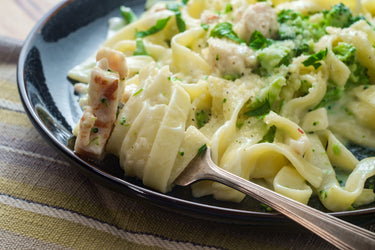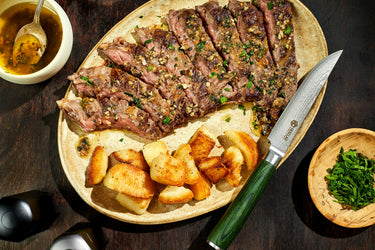How To Clean All Parts of a Burnt Pot

So you tried a new method of cooking in the kitchen, and it blew up in your face. Okay, maybe it didn’t blow up, but there are definitely burnt remnants of last night’s dinner now stuck to your most prized pan.
If this has happened to you, you’re not alone. Also, don’t panic. The best part about these fixes is that they’re all-natural, so you don’t have to worry about harsh chemicals on items your food touches.
Bottom line: don’t get down on yourself. Everyone makes mistakes in the kitchen. Now let’s get those gloves and get to work fixing it.
What Are the Best Ways To Clean a Burnt Pot?
Burnt bits on a pan are all part of the learning experience. Even well-seasoned chefs have trouble in the kitchen from time to time. It happens.
So today, we are here to give you a crash course on what to do when you have burnt parts on your pan. Spoiler alert: none of them include throwing it across the room.
There are always good ways to fix, clean, or do something, and then there are wrong ways. Harsh chemicals that require gloves for skin protection are definitely the wrong way when it comes to treating your pans.
Use the ingredients and cleaning products that are in your home. Choose products that are safe to use on the cooking surface of your pots and pans. We’ve got a few ideas. Here are the top ways to deal with stubborn stains and burnt spots on your cookware.
Boil Some Water in the Scorched Pot
Sometimes all it takes is a little water. For example, a cast iron pan is never meant to be cleaned with dish soap or dishwasher tablets. If you’ve seasoned your pan correctly, a burnt area on the bottom of the pan should come off with a little warm water.
Fill the pan about two inches deep with water and put it on your range. Turn it on to medium heat and let the water slowly boil off. Many times, the mixture of heat and water will be enough to loosen the bond between the pan and the food.
Then you’ll be able to rinse the pan clean or use a mild scrub brush to push food off the surface.
Boil Water and Vinegar for Tough Stains
For tougher stains, you’ll need to bring in the reinforcements. The first product we recommend is white vinegar.
White vinegar is made from fermenting sugars. Those sugars ferment into alcohol and are bottled. Once bottled, those residual sugars start the second process of turning the alcohol into acetic acid. This acid is what gives vinegar its strong smell and flavor profile.
The best part about this acetic acid, however, is that it’s strong. The pH balance is high. While it might not be your best bet at killing germs, it can help lift stubborn stains.
Adding vinegar to water and then boiling it inside the burnt pan can help clean off any food particles, gunk, or burnt area of the pan that scrubbing alone won’t fix. The acidic qualities of the vinegar work hard at removing the bond between food and a burnt pot, and in minutes you’ll see a difference.
You can always throw some lemon juice in there for good measure.
Scrub With Vinegar and Baking Soda
Vinegar is an amazing DIY cleaning method on its own, but sometimes a scorched pan is just really stuck. If you find that’s the case, then it’s time to employ the sidekick of your favorite burnt food fighting agent: baking soda.
Baking soda is a common cleaner and freshener to keep in the home, as well as a leavening agent for many baked goods. But baking soda is also tough on burnt foods while keeping pots and pans intact.
The important component of using these ingredients together is to keep the mixture in the vinegar’s benefit. You need the pH of the acid to react with the baking soda to remove tough stains. It might sound super scientific, but it’s an easy recipe.
Think of it as two parts vinegar to one part baking soda.
Mix the baking soda and vinegar at the bottom of a burnt pot and allow to sit for a few minutes. Once it’s ready to scrub, use a scouring pad to wash away the stubborn gunk. Any scorch marks or streaks should be gone with just a little elbow grease.
Should You Try the Aluminum Foil Method?
So a “cleaning hack” is gaining popularity, and it involves hot water and a ball of aluminum foil. The idea is that you add a cup of water to a dish, let it sit for a minute to soak into the pan, and then use a balled-up piece of aluminum foil to scrub the burnt areas.
This might help get rid of the stubborn stains, but we don’t think it’s the best method for your pans.
Why?
In addition to pulling up those burnt food particles that won’t leave the pan, a severe scrub has serious potential to ruin your pan, especially those with thin layers of non-stick coating. Unless you’re looking for a reason to toss the non-stick pan, you might want to stick to a different cleaning hack.
Pro Tip: HexClad hybrid technology means you can use a foil scrubber or a steel wool pad to clean. While this would destroy traditional nonstick, HexClad's proprietary design with peaks and valleys keeps your cookware safe.
The Dryer Sheet Method: Genius or Crazy?
Another crazy cleaning hack gaining momentum recently is the dryer sheet method. This cleaning solution involves warm water, dish soap, a dryer sheet, and a sponge.
To utilize this cleaning technique, you need to add warm or hot water to a pan, dish soap, and then a dryer sheet on top. Allow this all to soak together for at least 15 minutes or overnight, depending on how poorly your cooking went, and then wash off with a gentle sponge.
Thanks to this combination of the soapy water and dryer sheet, your stubborn stains should wipe clean away with minimal effort. Just make sure you add enough water.
If you don’t have a dryer sheet handy, allow just the soapy water to simmer in your pan for a few minutes while you do the rest of the dishes, then give it a shot in the same manner.
It sounds weird, we know, but it can be very effective.
How Do I Stop Burning My Pots and Pans?
The best bet to eliminate the need for all this deep cleaning is to eliminate the issue. That starts with better cooking practices for you.
Below are a few cooking tips to help you keep your pans cleaner and scorch-free.
Switch to Stainless Steel
A great way to ensure that your pans can stand up to any cooking you do in the kitchen is to switch to a pan that’s stronger and more durable. We mean a hybrid of aluminum and stainless steel.
Make the switch to our hybrid stainless steel cookware. It features a non-stick cooking surface to make food slide out of the pan instead of sticking to it.
When you season our hybrid stainless steel pans before the first use, we guarantee them for life. We believe in their quality and their ability to get the job done right.
Cook With Plenty of Oil
If you haven’t yet made the switch to our superior technology, your pan might be sticking and burning food due to the lack of moisture while you’re cooking. This means you need to amp up the amount of oil or butter in the pan no matter what you’re cooking.
Suppose you choose to go the HexClad route. In that case, a properly seasoned pan has a superior non-stick ability, which means you can safely use less oil in the pan without worrying about burnt food.
Non-Stick Cookware Is Worth It
You might not see the merit in non-stick cookware, but there are a lot of benefits. You can cook with a little more confidence knowing your food won’t stick to the pan, and with our hybrid cookware, you can use less oil for a healthier experience.
Use the Right Burner
Did you know that different burners are better for different jobs? With newer ranges, you’ll see a designated burner with high output, meaning the heat is a little extra on this burner.
Choose the burner that will give you the best simmering or searing power to make sure that your cooking results in better experiences for everyone. Of course, with HexClad, you don’t need to crank it up. Our pans cook food on low to medium heat, no problem.
Don’t Turn the Heat Too High
Many times, you’ll find that a lot of home cooks believe that higher heat is better for cooking. This is completely false. In fact, it’s better to use a pan at low-medium to medium heat for both the benefit of the pan and your meal.
At this heat or temperature, you can control the cooking time and the browning your food will undergo. If you cook the food on high heat, you’ll end up cooking the outside too fast, and the interior temperature of the food can’t keep up, which often results in burnt food.
Stir Often
Another mistake to avoid is forgetting to stir your ingredients. The longer rice, noodles, or veggies sit in the same spot on a pan, the higher the chance they burn.
Moving the food around won’t give veggies or protein time to caramelize and stick to the pan. It will ensure that all your ingredients have time to meet and mingle with one another. This will keep your food from burning and help all the flavors come together.
Time for a Cookware Upgrade
We are confident that our cleaning tricks and cooking tips will help you keep your food cooked perfectly and keep your pan burn-free.
New cooking techniques are fun. It’s always a good thing to push yourself in the kitchen, but not at the expense of your cookware. That’s why we think that perfecting your culinary expertise would be so much easier with upgraded pots and pans.
Order your new hybrid pans today and experience the difference that quality can make.
Sources:
What Is Vinegar and What Makes It a Good Cleaner? | TheKitchn
Why are Vinegar and Baking Soda so Good for Cleaning? | Live Science
How to Clean Pots and Glass Baking Pans with Dryer Sheets | Today





